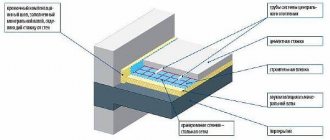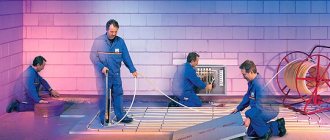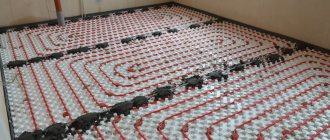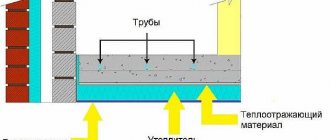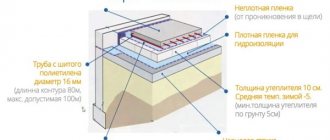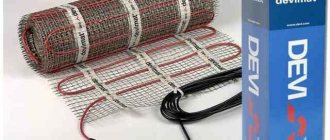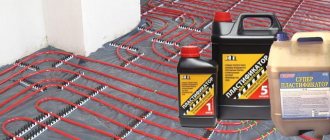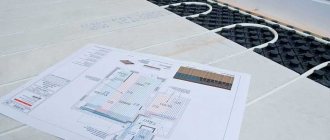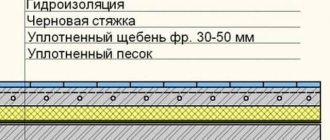When installing heated floors and most types of floor coverings, a special underlay is used, which performs a lot of functions. One of its most popular types is foil for underfloor heating. Some, trying to save on repair work, believe that they can refuse it. However, this step would be a grave mistake. An underlay must be used for installing heated floors.
Foil for heated floors
Types of heated floors
Before we get acquainted with foil underlays for installing floors, let’s find out what types of heated floors exist and can be used in rooms for various purposes. Depending on the type of system, different types of foil material are used, differing in certain properties.
Laying water heated floors
- Infrared thermal film. This is a thin film material equipped with heating elements, which is placed under the finishing coating. Thermal film differs from other types of underfloor heating in the heating method - it uses special radiation, like the sun's rays, to heat all objects around it. It is considered the best type of heated floor for laminate.
IR thermal film
- Heating cable and cable mats . In both cases, the heating element is a special thick cable that is laid in the concrete screed and heats it, and then the floor covering itself. In the first option, when laying the wires, the specialist himself determines the distance between the cable sections, and in the second, the wire is already built into special mesh mats - there is no need to calculate the distance, which makes installation of the heated floor system easier. This type is characterized by high energy consumption - it spends a lot of energy precisely on heating the concrete screed itself in which it is located, which reduces its efficiency.
- Water heated floor. The system is a pipe laid in a screed according to a certain pattern, into which hot water is supplied from the heating system. The coolant in this case is water, not electric current. The disadvantage of such a warm floor is the risk of leakage, and the height of the ceiling in this case is reduced, because in order to cover the pipes with a screed, you will have to use quite a lot of cement mortar (you will get a thick layer). And not every management company will allow you to install such a heated floor system.
Water heated floor
One of our articles will help you calculate a warm water floor . In it you will find a special calculator, calculation examples and installation instructions.
Why do you need a substrate?
The material that plays the role of a substrate for a heated floor system is necessary, first of all, to ensure that heat flows do not go down, do not spread below the concrete screed, but, on the contrary, go up, warming up the floor covering and the room.
Requirements for underfloor heating
On a note! Inside a regular floor, the heat emanating from the heating element will evenly heat the material from which the floor is made. However, it will no longer penetrate below the screed due to the thermal insulation layer.
At the same time, it is not just insulating material that allows you to retain heat much better and more efficiently, but a substrate with foil. As an example, it can be noted that the thermal insulation coefficient of 8 cm thick foam plastic will be exactly the same as that of foamed polyethylene with a layer of foil.
Underfloor heating
A high-quality underlay for heated floors should have:
- high reflection rates;
- resistance to temperature fluctuations;
- sound insulation;
- waterproofing;
- high thermal insulation rates;
- ease of installation;
- environmental and sanitary safety.
Materials with a layer of foil also have most of these properties. In particular, they have maximum properties reflecting thermal energy.
Warm infrared floor
The need to use a foil backing
Concrete screed takes a long time to heat up and cools down quickly.
Foil retains heat in the room Experts in laying underfloor heating systems unanimously confirm the need to lay a substrate. The thermal insulation layer prevents energy loss through the concrete screed layer. The low thermal conductivity coefficient is ensured by the structure of the material. Closed cells of synthetic fabrics filled with air and randomly laid mineral wool fibers are reliable heat insulators.
Foil under heated floors is used as reflective insulation. The metallized layer promotes uniform heating of the room. A significant coating area that directs infrared radiation into the room allows you to save up to 97% of energy. Using a substrate reduces the time it takes to warm up the room and reduces heating costs. The function of the material is also to protect the heating elements from moisture entering through the base.
When choosing a substrate, take into account the type of heated floor and the finishing floor covering. For a water floor system, choose rigid insulation that can withstand high loads. The aggressiveness of the concrete screed with which the pipes are poured should be taken into account. The substrate must have a protective coating. The option with a resistive or self-regulating heating cable can be laid under an adhesive solution that does not harm the aluminum film. For such a system, foil underfloor heating is the best choice.
One of the types of electric heated floors are heating mats. These are wires laid according to a diagram and secured to a fiberglass base. A substrate with an aluminum reflective surface is also effective for them. Infrared film mats placed under laminate, parquet or carpet can overheat the foil, causing a short circuit. For IR film, a metallized Mylar coated substrate is recommended.
Foil for underfloor heating
This material is used quite often when installing heated floors. It allows you to reduce heat loss during the use of the heating system, which makes it possible to save money spent on heating or electricity bills. Materials with a foil surface are considered the most effective in terms of energy saving.
Foil for underfloor heating
However, all of the above properties are possessed not only by the foil itself, but also by the materials on the surface of which it is glued during production. There are several main groups of thermal insulation materials that can have a foil layer.
Foil insulator for heated floors
Advantages and disadvantages
Foil floor underlay is highly efficient in terms of energy saving. Among the advantages of using this product, the following points are also noted:
- the height of the floor structure does not increase, since the thickness of the foil sheet varies between 2-10 mm;
- the material is easy to install, even novice craftsmen can do it;
- insulation with a reflective layer has noise-absorbing properties;
- the substrate with foil is able to withstand constant high temperature loads in the range of up to +90°C and above;
- a separate category of resources with a reflective coating is suitable for installing any type of heated floors;
- on the surface of most models of foil insulation, markings are made to simplify the process of laying elements of the heating structure;
- Some modifications of the material are equipped with an adhesive layer to facilitate installation work.
Foil for heated floors is an energy saving solution.
Among the disadvantages, note the high cost of the most effective types of foil insulation under heated floors. For example, multifoil is sold at a price of €5 m². Another disadvantage: mineral substrates with a metallized surface should not be used when installing heated floors. This is because, under the influence of high temperatures, toxic compounds are released from the material.
Structure of foil thermal insulation material
Most types of foil-coated thermal insulation materials are produced in rolls, which ensures ease of use during installation work. In general, most insulation materials have a two-layer structure - base and foil.
Thermal insulating foil is usually sold in rolls
The basis can be:
- basalt;
- mineral;
- polystyrene foam;
- polyethylene.
Each of these materials is environmentally friendly, safe for health due to its inertness, and has excellent fire safety performance. Also, most types of base have a bubble structure, and air, as you know, is one of the worst conductors of heat.
Foil polyethylene foam - structure
The foil layer is a foil made of aluminum, the role of which is to directly reflect thermal energy. It allows the returned heat to be evenly distributed, but the base prevents it from going into the screed.
On a note! Foil insulation is mostly elastic and soft materials, so the installation process is quite simple.
Necessary materials for laying film flooring under wooden and light coverings
Expert opinion
Afanasyev E.V.
Chief editor of the pol-exp.com project Engineer.
Due to the fact that most thermal insulation materials with a foil layer can withstand heating up to +90 degrees, such substrates can be used for any type of underfloor heating systems. By the way, on the surface of the foil insulation there are often markings that facilitate the process of laying the cable - you don’t have to constantly fiddle with a tape measure. With this material it is also easier to install a water floor system. Another feature of some foil materials is the sticky layer. It allows you to fix the insulation in one place during installation and will not allow it to move.
Film with reflective markings for heated floors
Which side to place the insulation with foil (penofol)
February 15, 2014. Read 112328 times
Insulation with foil is a highly effective heat-insulating material, the basis of which is foamed polyethylene, with a top coating in the form of aluminum foil, with good heat-reflecting ability.
For internal thermal insulation
The following types of insulation with foil can be used indoors:
A (foil on one side)
B (foil on both sides)
C (on one side there is a foil layer, on the other there is a self-adhesive layer)
For outdoor use
The following types of embossed insulation are used:
M (flat side coated with aluminum foil)
R (coated with aluminum foil on the embossed side)
When starting work, you should know which side to place the rolled insulation with foil when installing it. Insulation with foil should be laid with an aluminum screen inside the room, and the other side should be glued to the surface to be insulated. Foil is a good conductor of heat, so it should not heat up. For this purpose, material manufacturers recommend leaving an air gap of 2 cm between the finishing material and the screen. The gap plays the role of a heat insulator, so the remaining free space must be well sealed.
Types of thermal insulation with foil
| Photo | Name | Rating | Price | |
| #1 | Expanded polystyrene | ⭐ 96 / 100 | More details | |
| #2 | Foamed polyethylene | ⭐ 98 / 100 | More details | |
| #3 | Basalt insulation | ⭐ 85 / 100 | More details | |
| #4 | Minvata | ⭐ 78 / 100 | More details | |
| #5 | Multifoil | ⭐ 96 / 100 | More details | |
| #6 | Folgoizolon | ⭐ 93 / 100 | More details |
Expanded polystyrene
The most popular thermal insulation material used for heated floors is foil polystyrene foam. In general, it is able to cope with changes in air temperature from -180 to +180 degrees without damage, but, of course, in domestic conditions the floors definitely do not heat up to that extent.
Expanded polystyrene board with marked foil layer
pros
- Quite durable material that is not afraid of sudden temperature fluctuations.
- Also, polystyrene foam is not afraid of exposure to various chemicals.
- It is not afraid of rot, various pathogenic microorganisms do not settle on it, which also demonstrates the material as safe for human health.
Minuses
Low resistance to UV radiation.
Expanded polystyrene with foil layer
Mineral wool
Mineral wool is purchased and used much less frequently, even with a layer of foil. Such insulation is often used only in industrial facilities.
pros
- affordable price;
- low fire hazard class.
Minuses
Not suitable for installation of water heating systems. The fact is that in the event of a liquid leak, the material will easily become saturated with it and lose all its qualities - it will not be able to retain heat. And it is not recommended to use mineral wool for electric heated floors. The main reason for negative reviews is that this material, when heated, begins to release substances that negatively affect the body.
Mineral wool foil
foiled mineral wool
Polyethylene foam
Foamed polyethylene is another commonly used type of underfloor heating.
pros
- lasting;
- plastic;
- not afraid of moisture;
- various chemicals are not scary;
- pathogenic microorganisms do not settle on it.
- can be used both under water heated floors and under electric ones;
- the period of use can be very long.
Minuses
- fear of ultraviolet radiation, but under the floor covering sunlight will not reach the material.
Foamed polyethylene foil
Polyethylene foam foil
Basalt insulation
Basalt insulation has a base consisting of thin fibers of molten gabbro-basalt rocks. It is very similar to fiberglass, consisting of basalt rather than quartz.
pros
- Non-flammability.
- Vapor permeability.
- It is not afraid of sudden temperature changes and can easily withstand from -200 to +700 degrees, which is why it does not burn.
Minuses
- Seams not sealed.
Foil basalt insulation
basalt wool with foil layer
Folgoizolon
Folgoizolon is often used in the construction/repair of saunas and baths.
pros
- It is not afraid of moisture or sudden changes in temperature.
- The service life of the material is quite long.
- Doesn't rot.
- Has increased sound insulation properties.
- Safe from an environmental point of view.
Minuses
Folgoizolon is very expensive, so it is practically not used in residential buildings.
Folgoizolon
Folgoizolon
Multifoil
There is another type of thermal insulation with a foil layer. It is known as multifoil and consists of several layers. The foil layer is covered with bubbles filled with air, then polyethylene and polypropylene film are laid. Under the foil layer there is a special protective coating.
pros
- If you use this type of thermal insulation, heat loss will be reduced to a minimum.
- In addition, multifoil is not afraid of high humidity.
Minuses
Not detected.
Multifoil
Multifoil
Attention! When installing a heated floor system, you should not use materials intended for insulating walls and other parts of the building. On the floor they will experience strong mechanical stress, and therefore can quickly lose their properties. Only use materials that are specifically designed for installation on the floor.
Video - Penofol and its analogues
Do you need reflective foil for underfloor heating systems?
The most commonly used types of foil backing are polypropylene and polyethylene. But is such a layer needed when installing a heated floor, or is its necessity just an invention of marketers? So, the following fact speaks in favor of a thermal insulation substrate with a layer of foil - its use allows you to save about 90% of the heat emitted by a heated floor system. Thus, the amount of energy spent is significantly reduced. This alone is enough to recognize the need to use the material.
Thermal reflective underlay for heated floors
The foil backing has other advantages:
- it practically does not increase the thickness of the floor, since for the most part it is very thin (2-10 mm);
- affordable for everyone;
- easy to install;
- strong, durable.
Using material with foil
Installing foil under a heated floor is quite simple. With a 99% probability, even a novice builder will not encounter any difficulties or difficulties here. In order to lay this material on the subfloor, you will need scissors or a stationery knife, a tape measure, aluminum tape, and the heat-insulating material itself (for example, polyethylene foam).
Let's start installation
The following table will help you navigate the entire installation technique.
Table. Technology for laying foil under heated floors.
| Steps, photo | Description of actions |
Step 1 | The material is laid close to the wall. The process starts from the corner of the room. The edge of the roll of foil material is placed in the corner of the room with the reflective side up - it will always be directed towards the heat source. The roll is unrolled to the end of the wall, a strip of material of the required length is cut. |
Step 2 | In a similar way, the material is rolled out across the floor of the entire room. The strips are laid end to end. |
Step 3 | All installation seams are taped to ensure maximum heat and moisture insulation. |
Step 4 | Next, the installation of a floor heating system can be carried out, then the flooring is laid. |
However, it is worth remembering that the foil underlay must be laid on a thoroughly dried subfloor if it has been leveled and filled with building mixture. Then the work on installing thermal insulation is carried out, and then the selected underfloor heating system is installed according to the diagram and certain requirements. After this, again, depending on the requirements, it is either filled with a cement mixture or simply covered with a finishing coating.
The underlay must be laid on a carefully prepared subfloor
DIY foil laying technology
Foamed polyethylene is the most common material for the substrate.
Working with roll reflective insulation is available to the home craftsman. Installation of the material does not require special tools or knowledge. Required:
- roulette;
- scissors;
- aluminum tape.
The process of laying the lining begins after leveling and waterproofing the base. Cracks and recesses in the concrete screed are covered with mortar. Bituminous mastic or liquid glass is used as a moisture insulator. To fix the substrate you will need special glue.
Install on a wooden floor immediately after cleaning the coating. The best option is to purchase material with a self-adhesive base. If there is no sticky layer, then use double-sided tape. The material is cut according to the area of the room. The individual parts are joined without overlap and placed close to the walls. The canvases are laid with a heat-reflecting coating facing up. The seams between the strips are closed with metallized tape. The procedure ensures the tightness of the overall coating. The underfloor heating system is installed on the substrate. After checking it, the finishing floor covering is laid.

